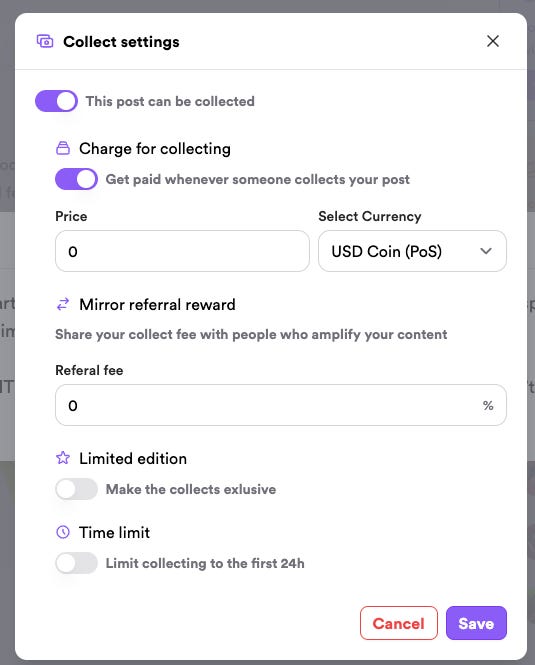Issue #10: How trading social content could impact the creator economy
Last week, LensPort launched a marketplace for trading Lens Protocol Collects—in other words, a secondary market to sell any web3 social posts you've collected.
I've written about Lens Protocol extensively on this newsletter, and if you've been following along, you'll be familiar with how publishing content to Lens works: every single post becomes an NFT that followers can "collect", store in their wallet, and show off as part of their online identity.
When a creator publishes a post on a Lens Protocol app (like Lenster), they can choose to let their fans collect the post for free, or charge them to collect it.
Creators can also make the post a limited edition (limit the number of NFTs available to collect) or make it available to collect for a limited time period only. It doesn't limit who can see the post or when they can see it; it simply makes the collectible item exclusive.
So then, why would someone pay money to collect a post that is free for anyone to view on the internet?
A massive benefit of web3 is that it essentially creates property rights for the internet. You can now "own" intangible objects, like content in this case.
Perhaps they're a superfan who wants to show off how obsessed they are. Just like how a basketball fanatic might collect a signed jersey from their favourite player (and probably show it off on social media), someone could collect a piece of content from their favourite creator.
Maybe they're curating a collection of content, like a Pokemon fan collecting trading cards.
Or, like those who invest in tangible collectibles, they could be speculating that this piece of content's value could go up as more people want to collect it in the future.
Regardless of what you call them—digital collectibles, collectible content, NFTs—they've been tricky to trade until now. LensPort makes trading them simple.
Now that we have an easier way to speculate on the future value of collectible content, we could see an increased incentive to pay to collect it. This rewards creators in a new way. It also incentivises them to create content worth collecting, so it's a win for content consumers too.
Of course, all of this hinges on the adoption of social apps built on Lens Protocol—and I've written previously about the challenges with web3 social. The catch-22 is that web3 social needs creator adoption if it has any chance of getting mainstream adoption, but creators need that mainstream adoption before they'll be incentivised to start using it.
Or perhaps they'll get so fed up with Web 2.0 social that they jump ship to one of the many web3 apps popping up with a focus on the creator economy.
Right now, creators get a bad deal. Web 2.0 social media platforms own their content and their audiences. Monetisation can be tricky, and creators receive a tiny fraction of the platform's ad revenue. If any at all.
Instagram announced this week that they're allowing select US creators to earn extra income—by displaying more ads in their profile feeds. In other words, Instagram is profiting off its top creators and positioning it as a benefit to creators by giving them a small percentage of the ad revenue.
Compare this with web3 social, where creators own their content, can monetise it freely, and don't have to fight against algorithms designed to maximise advertising revenue. We're right on the edge of a huge shift here.
If you've made it all the way down here, that means either you found this interesting, or you're on your way to the unsubscribe button at the bottom.
Either way, I'd love it if you could please take 2 minutes to let me know how I'm doing. What would you like to see more of? Less of?
Until next week,
Steph
PS. Did someone forward you this email? Click here to get the weekly emails straight to your inbox, minus the middleman.
This should go without saying, but I am a marketer, not a financial advisor. The content in this email is for educational purposes only and should not be taken as financial advice. Please take care and do your own research before investing in any web3 projects.


